Trenton
In the 1670s Quaker Mahlon Stacy bought land along the bank of the Delaware River in the Province of West New Jersey and in 1679 he was the leader of a group of Quakers who settled on the land to escape persecution back in England. Stacy later sold land around the settlement to Philadelphia trader William Trent and the settlement became known as Trent-towne. The name was eventually shortened to Trenton. During the Revolutionary War, Trenton was the site of General George Washington’s first victory over the British. It was a small victory, but after several losses in New York it was enough to boost morale and increase recruitment into the Continental Army. In late 1784, after the end of the Revolutionary War, the Confederation Congress met in Trenton making it for a short time the capital of the USA. The majority of northern states wanted to make Trenton the permanent capital, but the southern states wanted the capital located further south on the Potomac River and they won the day. Trenton’s consolation prize was to be made capital of New Jersey in 1790.
State House from West State Street
Perth Amboy had been the colonial capital of New Jersey but in 1790 the State of New Jersey moved its capital to Trenton. After selecting their capital many states took their time to build a State House or Capitol. New Jersey didn’t hang around, its first State House was built only two years later. It was small by modern standards, a two storey 7 bay building with a bell tower. Inevitably the government grew too big for the original building so it was extended in 1845 and 1871. A major fire in 1885 destroyed the wing that faced State Street. Jersey City architect Lewis Broome was selected reconstruct the wing, he designed a building in a simplified Second Empire style with three storeys and limestone facing. The original 1792 State House remained part of the building right though to 1906 when it was replaced by a four storey office building. Some further extension work was done in 1911 and 1912, but since then there have been no major additions. Plans in the 1960s to demolish most of State House were not implemented and in the 1980s the building underwent major renovation. Guided tours of State House are available. Click Tab 2 to see the rotunda and dome of the capitol.
Old Masonic Temple
Freemasonry started in England as fraternities of stonemasons established in the late 14th century to regulate the industry. It broadened into a more general fraternity and in the early 18th century it spread across Europe and to the American colonies. In 1730 Masons in New York, New Jersey and Pennsylvania asked the Grand Lodge of England to appoint a Provincial Grand Master of Masons in America. The first holder of this position was Colonel Daniel Coxe of Trenton, New Jersey. In 1786 the Grand Lodge of New Jersey was formed with Chief Justice David Brearley of Trenton as its grand master. Trenton was firmly on the Masonic map. In 1793 Trenton Lodge No. 5 built a Masonic Temple at the corner of Front and Willow (now Barrack) streets near the New Jersey State House, and across the street from the Old Barracks. Growth of Freemasonry in Trenton meant that the Temple was soon too small and by 1868 the building had been sold off to become a free school and later the workshop of a furnisher and upholsterer. In 1915 the building was bought and presented to the Grand Lodge of New Jersey. The old building was moved half a block south to 102 Barrack Street and a new temple was built on the original site. The Old Masonic Temple is now a tourist information centre.
Home > US States > Midatlantic USA > New Jersey >
Click on Minimap to navigate
Old Barracks
The harsh winter weather in North America ensured that wars in Colonial times were seasonal. This created a problem of where to house all of the troops in winter. The original solution in New Jersey was the compulsory billeting of soldiers in private homes. During the French & Indian War, when there were more troops around, the people of New Jersey revolted against this practise. As a result, in 1758 five barracks were built across New Jersey. The only one of these barracks still standing is the one built at Trenton. At times when Britain did not have enough troops of its own, it would rent additional troops from German princelings. The Landgraviate of Hesse-Kassel supplied many of the troops, so German troops in the pay of the British became known as ‘Hessians’. In mid December 1776 three regiments of Hessian soldiers arrived at their winter quarters at Trenton Barracks. With the Continental Army defeated in New York and forced to retreat to Pennsylvania, the Revolutionary War seemed lost. The weather was deteriorating but General George Washington decided on a last ditch attempt to defeat the British. On the night of December 25, Washington led 2,400 men across the Delaware River and they then marched to Trenton. They arrived on the morning of December 26 to find that the Hessians had concluded that fighting was over for the winter and were not guarding the town. The Hessians briefly tried to resist, but caught completely off guard, most of them soon surrendered. It was a small victory for the Continental Army but it raised morale and brought in new recruits. After the Revolutionary War part of the Barracks was demolished to extend Front Street towards the new State House but the remainder has been preserved as the Old Barracks Museum. Click Tab 2 to see an Officer's Room in the Old Barracks.
Kuser Mansion, Kuser Farm Park
In Hamilton Township on the outskirts of Trenton is a beautifully preserved example of over-the-top Victorian architecture. Rudolph Kuser arrived in the US from Switzerland in the mid 1800s and established a farm here. Rudolph and his wife Rosalie had six children who grew up to develop business interests that extended far beyond the farm. For example, Anthony Kuser’s business interests ultimately included electricity and gas supply as well as Fox Film Corporation. In 1892 Rudolph’s son Fred built a Queen Anne-style country home over the road from the farm as a summer residence for the family. The mansion and farm were purchased from the Kuser family by Hamilton Township in 1976. Since 1979 Kuser Mansion has been open as a house museum.
DLU170422


To move forwards or backwards through the New Jersey trail click the arrows above, or select your next destination on the Minimap.
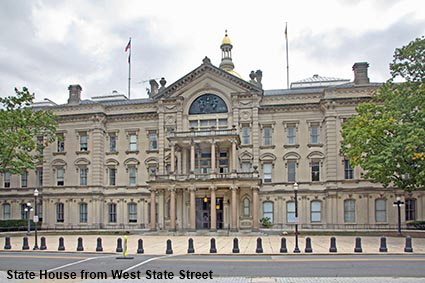
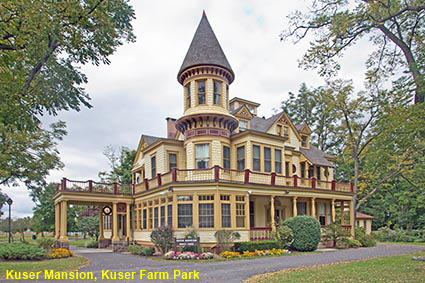
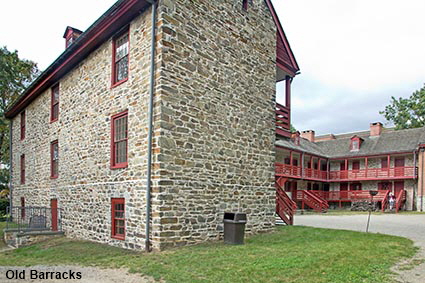
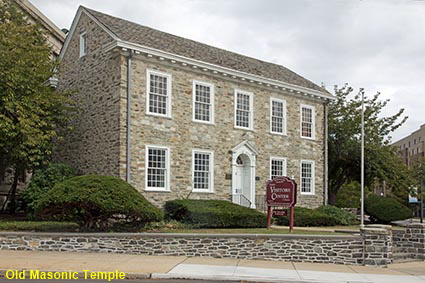
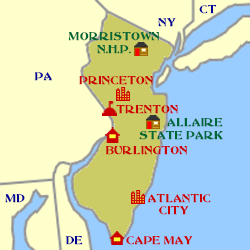
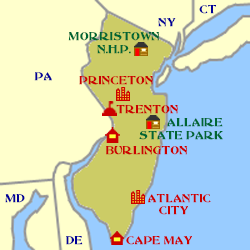
© Mike Elsden 1981 - 2025
The contents of this page may not be reproduced in full or in part without permission